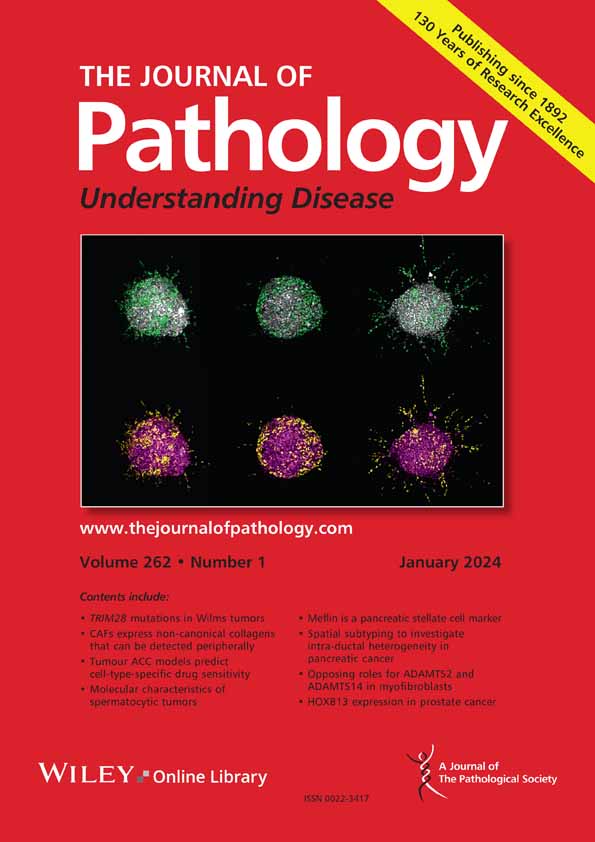Zhen Wang, Jin Yuan, Xuemei Qin, Hongzhen Yin, Changshun Zhong, Rui Qu, Guannan Wang
求助PDF
{"title":"在体外和体内研究中,LncRNA GAS5通过靶向miR-223-3p/FBXW7轴和灭活NF-κB信号通路来改善肠屏障损伤。","authors":"Zhen Wang, Jin Yuan, Xuemei Qin, Hongzhen Yin, Changshun Zhong, Rui Qu, Guannan Wang","doi":"10.1002/path.6440","DOIUrl":null,"url":null,"abstract":"<p>Sepsis is a potentially lethal syndrome that leads to multiple organ dysfunction. LncRNA <i>GAS5</i> is closely related to sepsis; however, its detailed functions and mechanism in sepsis-triggered intestinal barrier dysfunction are unclear. In this study, NCM460 cells were stimulated with lipopolysaccharide (LPS) to mimic septic intestinal injury <i>in vitro</i>, and a sepsis mouse model was established via the cecum ligation and perforation method. Terminal deoxynucleotidyl transferase dUTP nick end labeling staining was performed for cell apoptosis evaluation. RNA and protein levels were examined by RT-qPCR and western blotting, respectively. Additionally, cell permeability and intestinal mucosa permeability were measured. ELISA was utilized to detect inflammatory cytokine production. H&E staining was conducted for histologic examination of the intestine. Luciferase reporter and RNA pull-down assays were employed to verify the interaction between <i>GAS5</i>, <i>miR-223-3p</i>, and <i>FBXW7</i>. The results showed that <i>GAS5</i> was downregulated in LPS-exposed NCM460 cells as well as the intestine of septic mice. <i>GAS5</i> overexpression mitigated LPS-triggered intestinal epithelial cell damage and apoptosis <i>in vitro</i> and reduced pathological damage, inflammation, and intestinal hyperpermeability in septic mice. <i>GAS5</i> upregulated <i>FBXW7</i> by interacting with <i>miR-223-3p</i>. Depletion of <i>FBXW7</i> reversed the protective effects of <i>GAS5</i> overexpression <i>in vitro</i>. Additionally, <i>GAS5</i> overexpression inactivated NF-κB signaling in LPS-stimulated NCM460 cells. NF-κB inactivation exerted effects in septic mice similar to those observed with <i>GAS5</i> overexpression. In conclusion, <i>GAS5</i> ameliorates sepsis-triggered intestinal barrier disruption by mediating the <i>miR-223-3p</i>/<i>FBXW7</i> axis and inactivating NF-κB signaling. © 2025 The Pathological Society of Great Britain and Ireland. Published by John Wiley & Sons, Ltd.</p>","PeriodicalId":232,"journal":{"name":"The Journal of Pathology","volume":"267 1","pages":"25-39"},"PeriodicalIF":5.2000,"publicationDate":"2025-07-28","publicationTypes":"Journal Article","fieldsOfStudy":null,"isOpenAccess":false,"openAccessPdf":"","citationCount":"0","resultStr":"{\"title\":\"LncRNA GAS5 ameliorates intestinal barrier injury by targeting the miR-223-3p/FBXW7 axis and inactivating NF-κB signaling in vitro and in vivo\",\"authors\":\"Zhen Wang, Jin Yuan, Xuemei Qin, Hongzhen Yin, Changshun Zhong, Rui Qu, Guannan Wang\",\"doi\":\"10.1002/path.6440\",\"DOIUrl\":null,\"url\":null,\"abstract\":\"<p>Sepsis is a potentially lethal syndrome that leads to multiple organ dysfunction. LncRNA <i>GAS5</i> is closely related to sepsis; however, its detailed functions and mechanism in sepsis-triggered intestinal barrier dysfunction are unclear. In this study, NCM460 cells were stimulated with lipopolysaccharide (LPS) to mimic septic intestinal injury <i>in vitro</i>, and a sepsis mouse model was established via the cecum ligation and perforation method. Terminal deoxynucleotidyl transferase dUTP nick end labeling staining was performed for cell apoptosis evaluation. RNA and protein levels were examined by RT-qPCR and western blotting, respectively. Additionally, cell permeability and intestinal mucosa permeability were measured. ELISA was utilized to detect inflammatory cytokine production. H&E staining was conducted for histologic examination of the intestine. Luciferase reporter and RNA pull-down assays were employed to verify the interaction between <i>GAS5</i>, <i>miR-223-3p</i>, and <i>FBXW7</i>. The results showed that <i>GAS5</i> was downregulated in LPS-exposed NCM460 cells as well as the intestine of septic mice. <i>GAS5</i> overexpression mitigated LPS-triggered intestinal epithelial cell damage and apoptosis <i>in vitro</i> and reduced pathological damage, inflammation, and intestinal hyperpermeability in septic mice. <i>GAS5</i> upregulated <i>FBXW7</i> by interacting with <i>miR-223-3p</i>. Depletion of <i>FBXW7</i> reversed the protective effects of <i>GAS5</i> overexpression <i>in vitro</i>. Additionally, <i>GAS5</i> overexpression inactivated NF-κB signaling in LPS-stimulated NCM460 cells. NF-κB inactivation exerted effects in septic mice similar to those observed with <i>GAS5</i> overexpression. In conclusion, <i>GAS5</i> ameliorates sepsis-triggered intestinal barrier disruption by mediating the <i>miR-223-3p</i>/<i>FBXW7</i> axis and inactivating NF-κB signaling. © 2025 The Pathological Society of Great Britain and Ireland. Published by John Wiley & Sons, Ltd.</p>\",\"PeriodicalId\":232,\"journal\":{\"name\":\"The Journal of Pathology\",\"volume\":\"267 1\",\"pages\":\"25-39\"},\"PeriodicalIF\":5.2000,\"publicationDate\":\"2025-07-28\",\"publicationTypes\":\"Journal Article\",\"fieldsOfStudy\":null,\"isOpenAccess\":false,\"openAccessPdf\":\"\",\"citationCount\":\"0\",\"resultStr\":null,\"platform\":\"Semanticscholar\",\"paperid\":null,\"PeriodicalName\":\"The Journal of Pathology\",\"FirstCategoryId\":\"3\",\"ListUrlMain\":\"https://pathsocjournals.onlinelibrary.wiley.com/doi/10.1002/path.6440\",\"RegionNum\":2,\"RegionCategory\":\"医学\",\"ArticlePicture\":[],\"TitleCN\":null,\"AbstractTextCN\":null,\"PMCID\":null,\"EPubDate\":\"\",\"PubModel\":\"\",\"JCR\":\"Q1\",\"JCRName\":\"ONCOLOGY\",\"Score\":null,\"Total\":0}","platform":"Semanticscholar","paperid":null,"PeriodicalName":"The Journal of Pathology","FirstCategoryId":"3","ListUrlMain":"https://pathsocjournals.onlinelibrary.wiley.com/doi/10.1002/path.6440","RegionNum":2,"RegionCategory":"医学","ArticlePicture":[],"TitleCN":null,"AbstractTextCN":null,"PMCID":null,"EPubDate":"","PubModel":"","JCR":"Q1","JCRName":"ONCOLOGY","Score":null,"Total":0}
引用次数: 0
引用
批量引用





 求助内容:
求助内容: 应助结果提醒方式:
应助结果提醒方式:


